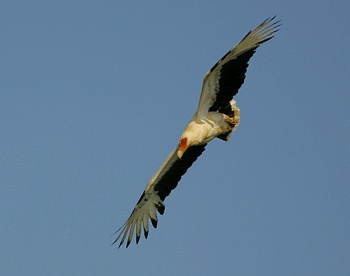- Gypohierax angolensis
Identification
57–65 cm (22½-25½ in); males slightly smaller than females.
Adult
- overall black and white
- body and primaries white
- scapulars, secondaries, median and greater secondary wing coverts black. All primary coverts black
- lesser secondary coverts white
- tail black with white terminal band
- iris and cere yellow
- face pinkish to orange-red (depending on bird's state of arousal)
- feet dull pinkish
- bill pale ivory
Immature
- dirty brown
- facial skin duller, more subdued
It takes 3-4 years to acquire adult plumage. Adults sometimes are stained buffy-brownish, but differ in having primaries with very short black tips, more extensive black in subadult and younger birds.
(Descriptions based on photos here and at ref. [5].)
Distribution
Sub-Saharan Africa:
Western Africa: found in Senegambia, Senegal, The Gambia, Guinea-Bissau, Guinea, Mali, Sierra Leone, Liberia, Ivory Coast, Burkina Faso, Ghana, Togo, Benin, Nigeria, Chad, Cameroon, Central African Republic, Equatorial Guinea, Gabon, Democratic Republic of Congo, Angola
Eastern Africa: Sudan, South Sudan, Kenya, Uganda, Burundi, Tanzania, Zambia, Mozambique, Malawi
Southern Africa: South Africa, KwaZulu-Natal
African Islands: Gulf of Guinea Islands: Bioko (Fernando Po)
Taxonomy
Subspecies
Clements regards this as a monotypic species [1].
Habitat
Tropical rainforest, mangrove swamps, heavily-wooded savanna areas and palm plantations.
Behaviour
Diet
Their diet consists mostly of the fruit of Oil Palm Elaeis guineensis; also dead fish, dates, crab, snails and molluscs.
Breeding
They build their stick nest high up in large trees. The nest can be 1 metre wide and .5 metre deep. The clutch contains a single egg, which is heavily marked with dark brown and chocolate, with lilac and pale brown undermarkings. Incubation takes about 44 days. The fledging period is long, frequently more than 90 days, giving a total breeding cycle time of about five months.
References
- Clements, J. F., T. S. Schulenberg, M. J. Iliff, D. Roberson, T. A. Fredericks, B. L. Sullivan, and C. L. Wood. 2018. The eBird/Clements checklist of birds of the world: v2018. Downloaded from http://www.birds.cornell.edu/clementschecklist/download/
- Avibase
- Birdforum thread discussing aging of this species
- Handbook of the Birds of the World Alive (retrieved December 2018)
- Macauley Library at https://www.macaulaylibrary.org
Recommended Citation
- BirdForum Opus contributors. (2025) Palm-nut Vulture. In: BirdForum, the forum for wild birds and birding. Retrieved 29 April 2025 from https://www.birdforum.net/opus/Palm-nut_Vulture
External Links
GSearch checked for 2020 platform.1






